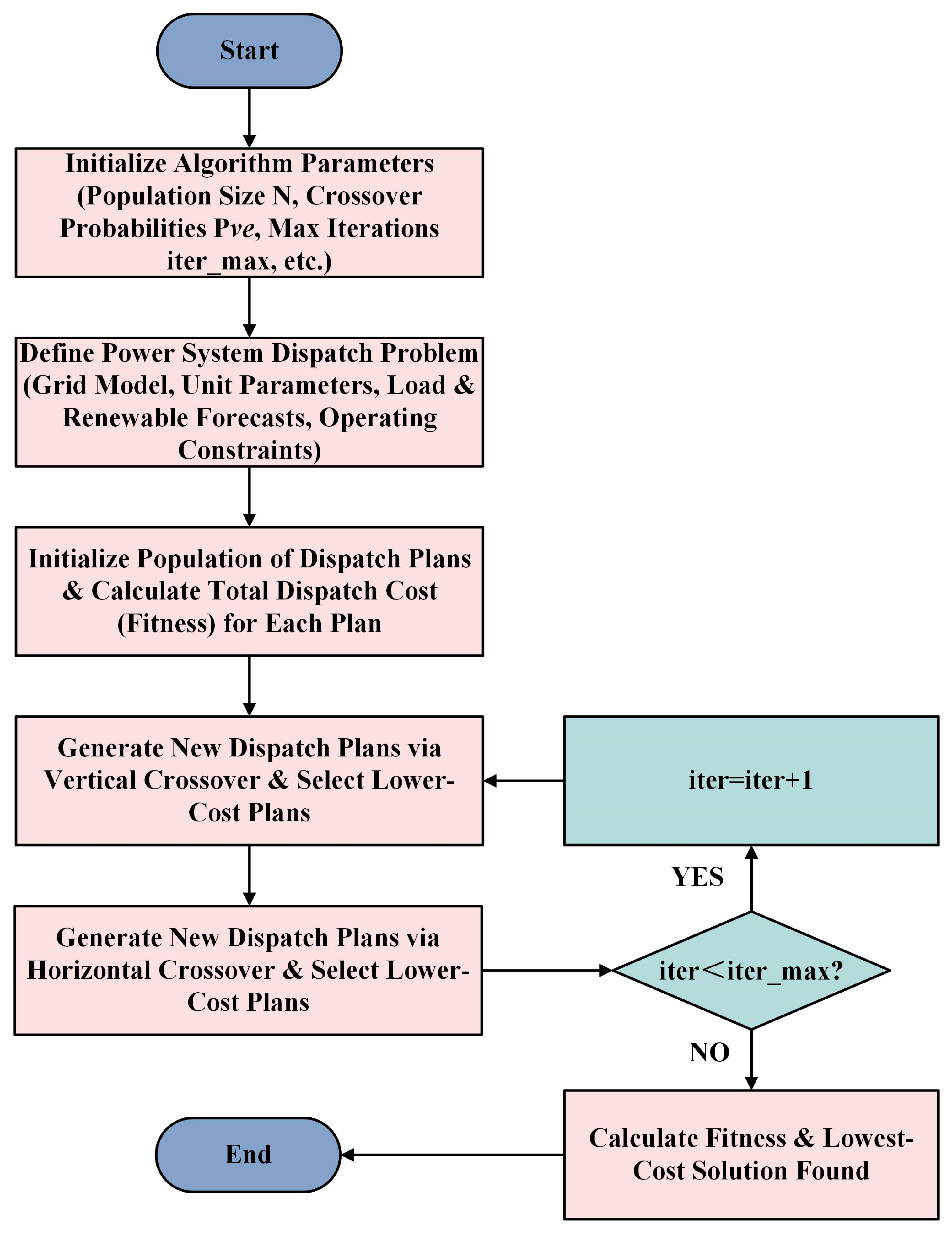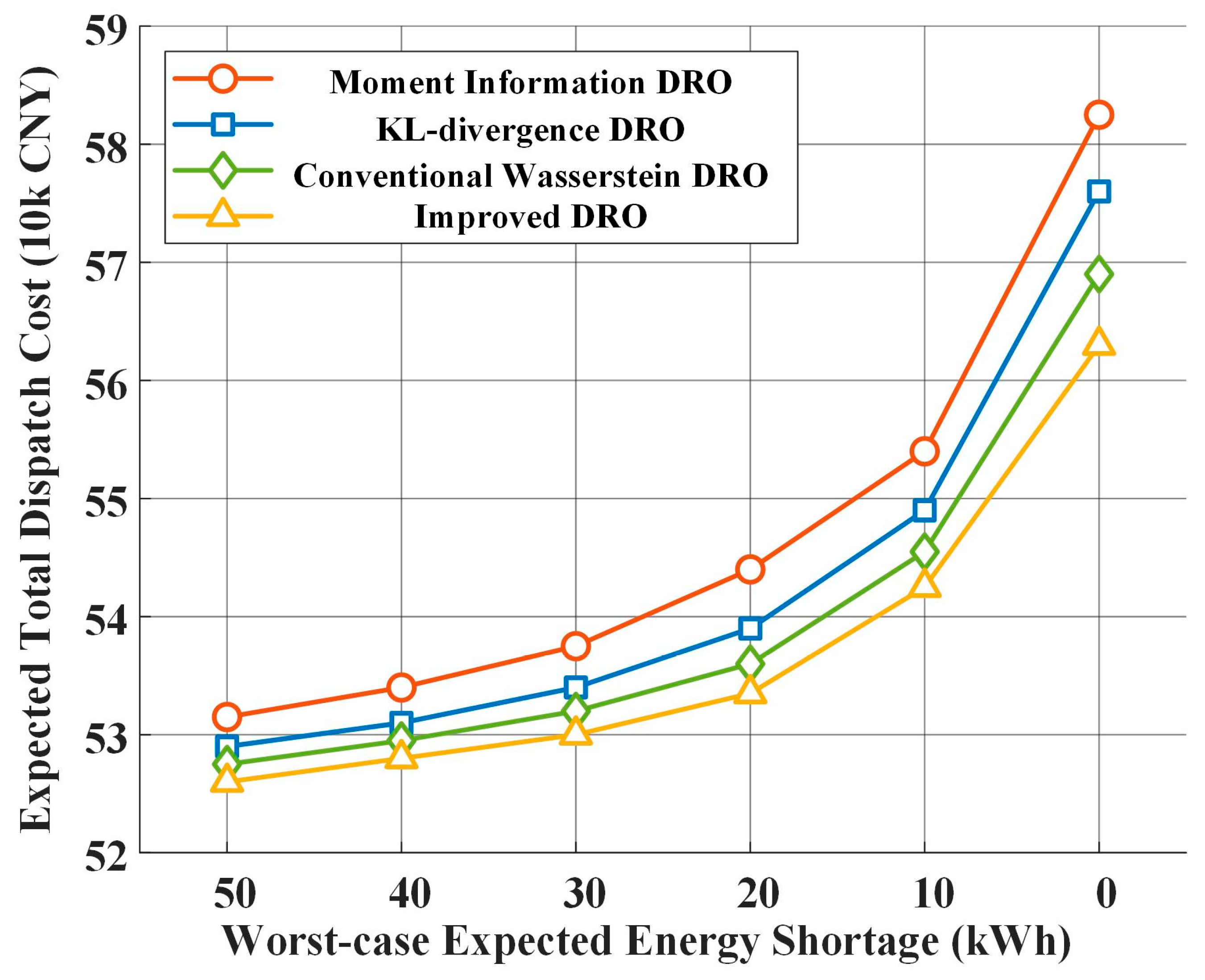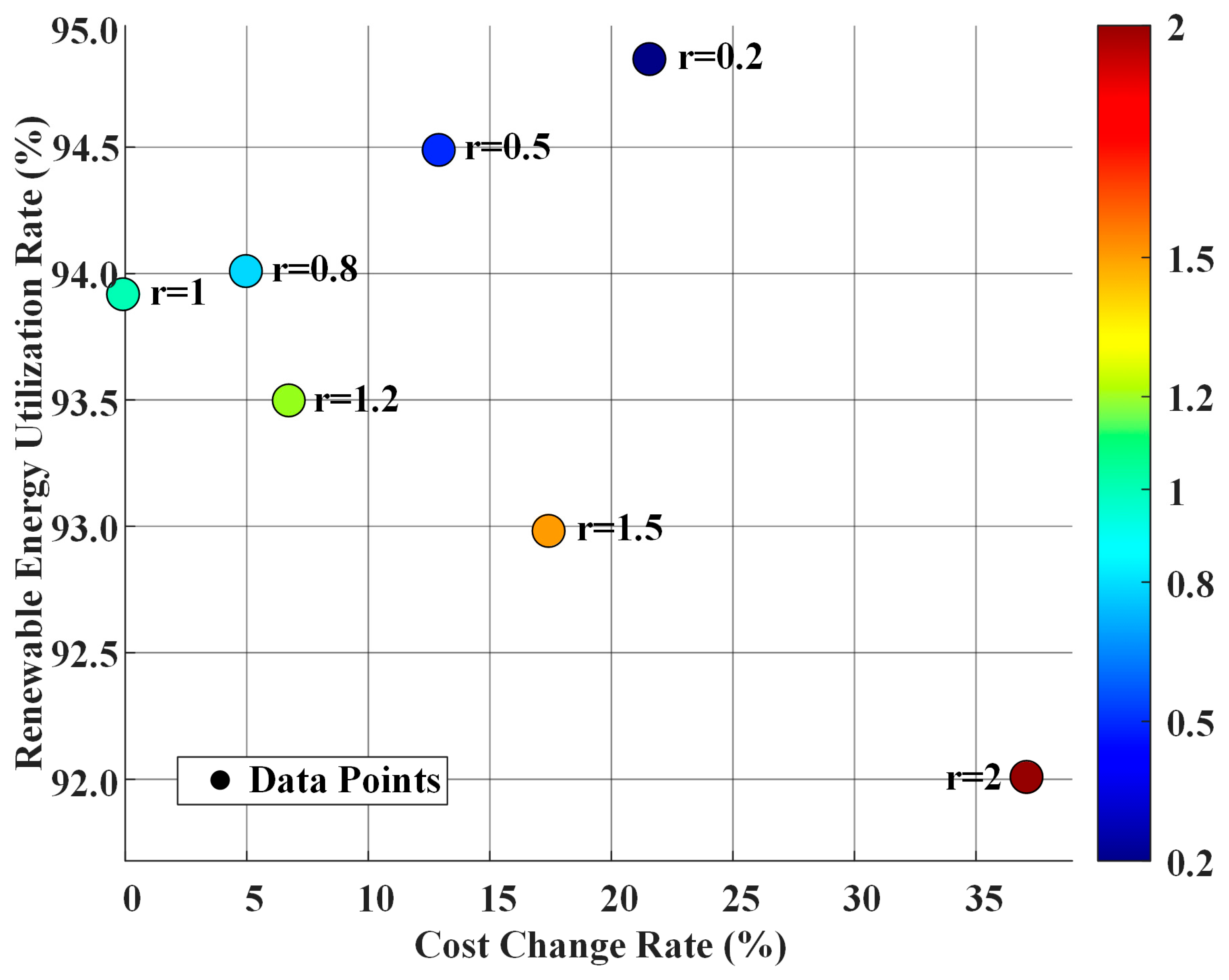A Wasserstein Distance-Based Distributionally Robust Optimization Strategy for a Renewable Energy Power Grid Considering Meteorological Uncertainty
Abstract
1. Introduction
- It gnores their correlations and dependencies on external factors, especially the impact of meteorological conditions on renewable energy output. In actual application, the operational parameters of power systems with renewable energy are significantly influenced by covariates such as weather conditions, seasonal changes, and geographical locations, exhibiting the complex spatiotemporal correlations [33,34].
- The proposed optimization method based on the improved Wasserstein distance introduces covariates to quantify the correlation between uncertain parameters such as meteorological conditions, and builds a probability distribution ambiguity set centered on the empirical distribution and measured by the Wasserstein distance. By adjusting the Wasserstein sphere radius to quantify the degree of uncertainty and solving the optimal decision under the most unfavorable distribution in this ambiguity set, the robustness of the system under adverse weather conditions is improved.
- By employing the linear decision rules (LDRs) and duality theory, the optimization problem is transformed into a solvable mixed-integer linear programming form, and the crisscross optimization (CSO) algorithm is applied to solve the large-scale DRO problem.
2. Meteorological Uncertainty Quantification Method Based on Wasserstein Distance
2.1. The Wasserstein Distance
2.2. The Wasserstein Distance Ambiguity Set with Covariates
2.3. Linear Decision Rules
3. Distributionally Robust Dispatch Strategy
3.1. Objective Function
- (1)
- Day-ahead Decision Costs
- (2)
- Intra-day Decision Costs
3.2. Operational Constraints
- (1)
- Power Flow Constraints:
- (2)
- Generation Unit Constraints:
- (3)
- Uncertainty Parameter Constraints:
- (4)
- Energy Storage System Constraints:
3.3. Model Dualization
3.4. Distributionally Robust Optimal Dispatching
3.4.1. Uncertainty Optimization Methods
3.4.2. Distributionally Robust Optimal Dispatching Based on the CSO Algorithm
- (1)
- Population Initialization: Define the population as the set of all possible dispatch plans X, where X = [X1;…;XN]. The dimension of each particle is m = d × 24, where d represents the number of nodes with dispatchable units, and each dimension’s value corresponds to the power output at that node for each of the 24 h. Let N be the population size, Pve be the vertical crossover probability, and f be the maximum number of iterations.
- (2)
- Fitness Calculation: The objective function of the distributionally robust optimization model is used as the fitness function for each particle. The fitness of each particle in the population is calculated in every generation. The particle with the optimal fitness value is recorded as the generation’s best.
- (3)
- Vertical Crossover: Vertical crossover is performed across all particles in the population, exchanging parameters between different dimensions. The decision to perform the crossover is based on the vertical crossover probability Pve. If a crossover is executed, a new offspring individual is generated as follows:where cr is a crossover coefficient in [0, 1], and r1 is a random number in [−1, 1]. m1, m2 are two random dimension indices. The particles generated through vertical crossover form the new generation. Any values exceeding the upper or lower bounds are replaced by the boundary values.
- (4)
- Horizontal Crossover: Horizontal crossover randomly selects two parent particles, X(i) and X(j), and performs a parameter crossover within the same dimension to produce offspring individuals LEk(i,m), LEk(j,m):where c1, c2 are crossover coefficients in [0, 1], and s1, s2 are random numbers in [−1, 1]. The particles generated through horizontal crossover form the new generation. Any values exceeding the upper or lower bounds are replaced by the boundary values.
- (5)
- Termination Condition: The fitness of each particle in every new generation is calculated to find the particle with the best fitness value, gbest. The algorithm checks if the current iteration count has reached the maximum number of iterations, f. If not, it returns to step (3) for the next iteration cycle. If yes, the loop terminates, and the fitness value of the optimal particle gbest is output.
4. Results and Discussion
4.1. Simulation Setup
4.2. Analysis of the Distributionally Robust Optimization Results
4.2.1. Impact of the Wasserstein Radius on System Dispatch
4.2.2. Comparison of Dispatching Strategy with the Proposed and Other Methods
5. Conclusions
- (1)
- The ambiguity set constructed based on the improved Wasserstein distance can effectively describe the uncertainty of renewable energy output under meteorological conditions. The Wasserstein distance DRO model, which introduces covariate factors, can more accurately describe the correlation between meteorological conditions and the output of renewable energy. By taking into account meteorological factors such as temperature, surface horizontal radiation, normal direct radiation, and scattered radiation, the model can adjust the decision-making strategy according to the uncertain characteristics under different meteorological conditions, improving the adaptability and accuracy of the model.
- (2)
- The optimization problem is transformed into a solvable mixed integer linear programming form by adopting linear decision rules and dual theorems, and an improved DRO strategy based on the CSO algorithm is proposed to solve large-scale optimization problems, which significantly improves the solution efficiency. The simulation results of the IEEE-33 node system verify the effectiveness of the proposed method in balancing the economy and robustness of the power system, providing a new technical path for the optimal dispatching of the power system with a high proportion of renewable energy.
- (3)
- Regarding the energy structure, the proposed method achieves a rational allocation between conventional and renewable energy, avoiding the overly optimistic drawback of deterministic optimization and the overly conservative drawback of robust optimization. It is a known theoretical property that as the amount of historical data increases, the ambiguity set shrinks, and the model’s solution tends to converge toward that of stochastic optimization. This indicates that the proposed model possesses lower conservatism than traditional robust optimization, enabling it to reduce operating costs while ensuring system security.
- (4)
- For grid operators, this method provides a practical decision-making tool that balances economic costs and renewable energy integration while ensuring system security. Although the dualized MILP problem faces the “curse of dimensionality” in large-scale systems, the proposed CSO algorithm demonstrates excellent scalability by finding high-quality, near-optimal solutions within an acceptable timeframe, thereby offering significant engineering value for practical dispatch in real-world power grids.
- (5)
- When scaling the model to larger, geographically dispersed transmission systems, the spatial correlation between photovoltaic outputs is indeed an important factor that cannot be ignored. In this study, modeling of the spatial correlation among PV sites in different geographical locations in the IEEE-33 node system failed. In future research, we will incorporate this correlation into the construction of ambiguity sets to further enhance the accuracy and economy of the model.
Author Contributions
Funding
Data Availability Statement
Conflicts of Interest
References
- Swadi, M.; Kadhim, D.J.; Salem, M.; Tuaimah, F.M.; Majeed, A.S.; Alrubaie, A.J. Investigating and predicting the role of photovoltaic, wind, and hydrogen energies in sustainable global energy evolution. Glob. Energy Interconnect. 2024, 7, 429–445. [Google Scholar] [CrossRef]
- Harmailil, I.O.; Sultan, S.M.; Tso, C.P.; Fudholi, A.; Mohammad, M.; Ibrahim, A. The State of the Art of Photovoltaic Module Cooling Techniques and Performance Assessment Methods. Symmetry 2024, 16, 412. [Google Scholar] [CrossRef]
- Qiu, J.; Zhao, J.; Wen, F.; Zhao, J.; Gao, C.; Zhou, Y.; Tao, Y.; Lai, S. Challenges and Pathways of Low-Carbon Oriented Energy Transition and Power System Planning Strategy: A Review. IEEE Trans. Netw. Sci. Eng. 2024, 11, 5396–5416. [Google Scholar] [CrossRef]
- Gui, Y.; Nainar, K.; Bendtsen, J.D.; Diewald, N.; Iov, F.; Yang, Y.; Blaabjerg, F.; Xue, Y.; Liu, J.; Hong, T.; et al. Voltage Support With PV Inverters in Low-Voltage Distribution Networks: An Overview. IEEE J. Emerg. Sel. Top. Power Electron. 2024, 12, 1503–1522. [Google Scholar] [CrossRef]
- Caetano, N.R. Review on the Theoretical and Practical Applications of Symmetry in Thermal Sciences, Fluid Dynamics, and Energy. Symmetry 2025, 17, 1240. [Google Scholar] [CrossRef]
- Jordan, D.C.; Perry, K.; White, R.; Deline, C. Extreme Weather and PV Performance. IEEE J. Photovolt. 2023, 13, 830–835. [Google Scholar] [CrossRef]
- Qin, Z.; Chen, X.; Hou, Y.; Liu, H.; Yang, Y. Coordination of Preventive, Emergency and Restorative Dispatch in Extreme Weather Events. IEEE Trans. Power Syst. 2022, 37, 2624–2638. [Google Scholar] [CrossRef]
- Belaïd, F.; Al-Sarihi, A.; Al-Mestneer, R. Balancing climate mitigation and energy security goals amid converging global energy crises: The role of green investments. Renew. Energy 2023, 205, 534–542. [Google Scholar] [CrossRef]
- Yu, G.Z.; Lu, L.; Tang, B.; Wang, S.Y.; Chung, C.Y. Ultra-Short-Term Wind Power Subsection Forecasting Method Based on Extreme Weather. IEEE Trans. Power Syst. 2023, 38, 5045–5056. [Google Scholar] [CrossRef]
- Wang, J.; Zhang, X.; Wang, Y.; Yang, S.; Wang, S.; Xie, Y.; Gong, J.; Lin, J. Power system source-load forecasting based on scene generation in extreme weather. Energy 2025, 330, 136991. [Google Scholar] [CrossRef]
- Fang, F.; Yu, S.; Xin, X. Data-Driven-Based Stochastic Robust Optimization for a Virtual Power Plant With Multiple Uncertainties. IEEE Trans. Power Syst. 2022, 7, 456–466. [Google Scholar] [CrossRef]
- Wang, Q.; Ortega-Vazquez, M.; Tuohy, A.; Ela, E.; Bello, M.; Kirk-Davidoff, D.; Hobbs, W.B.; Kumar, V. Assessing Dynamic Reserves vs. Stochastic Optimization for Effective Integration of Operating Probabilistic Forecasts. IEEE Trans. Sustain. Energy 2025, 16, 2132–2143. [Google Scholar] [CrossRef]
- Xiong, H.; Shi, Y.; Shahidehpour, M.; Guo, C.; Zhou, Y. Multi-Stage Robust Optimization of Real-Time Dynamic Dispatch With Fast-Acting Units in Resilient Power Systems. IEEE Trans. Power Syst. 2025, 40, 18–30. [Google Scholar] [CrossRef]
- Xu, X.; Gao, Y.; Wang, H.; Yan, Z.; Shahidehpour, M.; Tan, Z. Distributionally Robust Optimization of Photovoltaic Power With Lifted Linear Decision Rule for Distribution System Voltage Regulation. IEEE Trans. Sustain. Energy 2024, 15, 758–772. [Google Scholar] [CrossRef]
- Zhang, X.; Liu, S.; Pan, J. Two-Stage Distributionally Robust Optimization for an Asymmetric Loss-Aversion Portfolio via Deep Learning. Symmetry 2025, 17, 1236. [Google Scholar] [CrossRef]
- Qu, K.; Chen, Y.; Zhao, C. Distributionally Robust Energy and Reserve Dispatch with Distributed Predictions of Renewable Energy. IEEE Trans. Power Syst. 2025, in press. [CrossRef]
- Lin, Z.; Wu, Q.; Chen, H.; Ji, T.; Xu, Y.; Sun, H. Scenarios-Oriented Distributionally Robust Optimization for Energy and Reserve Scheduling. IEEE Trans. Power Syst. 2023, 38, 2943–2946. [Google Scholar] [CrossRef]
- Son, Y.G.; Kim, S.Y. Optimal planning and operation of integrated energy systems in South Korea: Introducing a Novel ambiguity set based distributionally robust optimization. Energy 2024, 307, 132503. [Google Scholar] [CrossRef]
- Lin, B.; Huang, Y.; Yu, D.; Fu, C.; Chen, C. Stochastic Distributionally Robust Optimization Scheduling of High-Proportion New Energy Distribution Network Considering Detailed Modeling of Energy Storage. Processes 2025, 13, 2230. [Google Scholar] [CrossRef]
- Xie, R.; Wei, W.; Li, M.; Dong, Z.; Mei, S. Sizing capacities of renewable generation, transmission, and energy storage for low-carbon power systems: A distributionally robust optimization approach. Energy 2023, 263, 125653. [Google Scholar] [CrossRef]
- Arrigo, A.; Kazempour, J.; De Grève, Z.; Toubeau, J.F.; Vallée, F. Embedding Dependencies Between Wind Farms in Distributionally Robust Optimal Power Flow. IEEE Trans. Power Syst. 2023, 38, 5156–5169. [Google Scholar] [CrossRef]
- Ryu, M.; Nagarajan, H.; Bent, R. Mitigating the Impacts of Uncertain Geomagnetic Disturbances on Electric Grids: A Distributionally Robust Optimization Approach. IEEE Trans. Power Syst. 2022, 37, 4258–4269. [Google Scholar] [CrossRef]
- Poolla, B.K.; Hota, A.R.; Bolognani, S.; Callaway, D.S.; Cherukuri, A. Wasserstein Distributionally Robust Look-Ahead Economic Dispatch. IEEE Trans. Power Syst. 2021, 36, 2010–2022. [Google Scholar] [CrossRef]
- Maghami, A.; Ursavas, E.; Cherukuri, A. A Two-Step Approach to Wasserstein Distributionally Robust Chance- and Security-Constrained Dispatch. IEEE Trans. Power Syst. 2024, 39, 1447–1459. [Google Scholar] [CrossRef]
- Yin, C.; Dong, J.; Zhang, Y. Distributionally Robust Bilevel Optimization Model for Distribution Network With Demand Response Under Uncertain Renewables Using Wasserstein Metrics. IEEE Trans. Sustain. Energy 2025, 16, 1165–1176. [Google Scholar] [CrossRef]
- Ma, X.; Ning, C.; Li, L.; Qiu, H.; Gu, W.; Dong, Z. Bayesian Nonparametric Two-Stage Distributionally Robust Unit Commitment Optimization: From Global Multimodality to Local Trimming-Wasserstein Ambiguity. IEEE Trans. Power Syst. 2024, 39, 6702–6715. [Google Scholar] [CrossRef]
- Esfahani, M.; Alizadeh, A.; Amjady, N.; Kamwa, I. A distributed VPP-integrated co-optimization framework for energy scheduling, frequency regulation, and voltage support using data-driven distributionally robust optimization with Wasserstein metric. Appl. Energy 2024, 361, 122883. [Google Scholar] [CrossRef]
- Zhai, J.; Jiang, Y.; Shi, Y.; Jones, C.N.; Zhang, X.P. Distributionally Robust Joint Chance-Constrained Dispatch for Integrated Transmission- Distribution Systems via Distributed Optimization. IEEE Trans. Smart Grid 2022, 13, 2132–2147. [Google Scholar] [CrossRef]
- Jin, X.; Liu, B.; Liao, S.; Cheng, C.; Zhang, Y.; Zhao, Z.; Lu, J. Wasserstein metric-based two-stage distributionally robust optimization model for optimal daily peak shaving dispatch of cascade hydroplants under renewable energy uncertainties. Energy 2022, 260, 125107. [Google Scholar] [CrossRef]
- Chen, G.; Zhang, H.; Hui, H.; Song, Y. Fast Wasserstein-Distance-Based Distributionally Robust Chance-Constrained Power Dispatch for Multi-Zone HVAC Systems. IEEE Trans. Smart Grid 2021, 12, 4016–4028. [Google Scholar] [CrossRef]
- Dong, G.; Zhu, Z.; Lou, Y.; Yu, J.; Wu, L.; Wei, J. Optimal Charging of Lithium-Ion Battery Using Distributionally Robust Model Predictive Control With Wasserstein Metric. IEEE Trans. Ind. Inform. 2024, 20, 7630–7640. [Google Scholar] [CrossRef]
- Chen, B.; Liu, T.; Liu, X.; He, C.; Nan, L.; Wu, L.; Su, X.; Zhang, J. A Wasserstein Distance-Based Distributionally Robust Chance-Constrained Clustered Generation Expansion Planning Considering Flexible Resource Investments. IEEE Trans. Power Syst. 2023, 38, 5635–5647. [Google Scholar] [CrossRef]
- Zhou, A.; Khodayar, M.E.; Wang, J. Distributionally Robust Optimal Scheduling With Heterogeneous Uncertainty Information: A Framework for Hydrogen Systems. IEEE Trans. Sustain. Energy 2024, 15, 1933–1945. [Google Scholar] [CrossRef]
- Liu, H.; Qiu, J.; Zhao, J. A data-driven scheduling model of virtual power plant using Wasserstein distributionally robust optimization. Int. J. Electr. Power Energy Syst. 2022, 137, 107801. [Google Scholar] [CrossRef]
- Li, J.; Khodayar, M.E.; Wang, J.; Zhou, B. Data-Driven Distributionally Robust Co-Optimization of P2P Energy Trading and Network Operation for Interconnected Microgrids. IEEE Trans. Smart Grid 2021, 12, 5172–5184. [Google Scholar] [CrossRef]
- Li, J.; Xu, Z.; Liu, H.; Wang, C.; Wang, L.; Gu, C. A Wasserstein Distributionally Robust Planning Model for Renewable Sources and Energy Storage Systems Under Multiple Uncertainties. IEEE Trans. Sustain. Energy 2023, 14, 1346–1356. [Google Scholar] [CrossRef]










| Method | Complexity | Conservatism | Economy |
|---|---|---|---|
| RO | Low | High | Low |
| SO | Medium | Low | High |
| Conventional DRO | High | Medium | Medium |
| Improved DRO | High | Adjustable, Low-Medium | High |
| Unit Type | Connection Node | Capacity (kW) |
|---|---|---|
| Thermal | 1, 6 | 3500, 1000 |
| PV | 18, 25 | 960, 500 |
| ESS | 16 | 500 |
| Parameters | Unit Value |
|---|---|
| Operational costs for thermal generating units | 149.52 CNY/MWh |
| Start-up costs for thermal generating units | CNY 5268.81 |
| Operational costs for energy storage systems | 0.85 CNY/MWh |
| System reference voltage | 12.66 kV |
| Ramp-up and ramp-down limits of thermal units | 0.30 p.u./h |
| Solving Method | Cost (CNY 10 k) | Time (s) |
|---|---|---|
| Solver (Gurobi) | 53.2 | 32 |
| PSO | 56.7 | 22 |
| CSO | 53.8 | 13 |
Disclaimer/Publisher’s Note: The statements, opinions and data contained in all publications are solely those of the individual author(s) and contributor(s) and not of MDPI and/or the editor(s). MDPI and/or the editor(s) disclaim responsibility for any injury to people or property resulting from any ideas, methods, instructions or products referred to in the content. |
© 2025 by the authors. Licensee MDPI, Basel, Switzerland. This article is an open access article distributed under the terms and conditions of the Creative Commons Attribution (CC BY) license (https://creativecommons.org/licenses/by/4.0/).
Share and Cite
Liu, Y.; Luo, L.; Li, X.; Liu, H.; Yu, Z.; Wang, Y. A Wasserstein Distance-Based Distributionally Robust Optimization Strategy for a Renewable Energy Power Grid Considering Meteorological Uncertainty. Symmetry 2025, 17, 1602. https://doi.org/10.3390/sym17101602
Liu Y, Luo L, Li X, Liu H, Yu Z, Wang Y. A Wasserstein Distance-Based Distributionally Robust Optimization Strategy for a Renewable Energy Power Grid Considering Meteorological Uncertainty. Symmetry. 2025; 17(10):1602. https://doi.org/10.3390/sym17101602
Chicago/Turabian StyleLiu, Yao, Lei Luo, Xiaoteng Li, Haolu Liu, Zihan Yu, and Yu Wang. 2025. "A Wasserstein Distance-Based Distributionally Robust Optimization Strategy for a Renewable Energy Power Grid Considering Meteorological Uncertainty" Symmetry 17, no. 10: 1602. https://doi.org/10.3390/sym17101602
APA StyleLiu, Y., Luo, L., Li, X., Liu, H., Yu, Z., & Wang, Y. (2025). A Wasserstein Distance-Based Distributionally Robust Optimization Strategy for a Renewable Energy Power Grid Considering Meteorological Uncertainty. Symmetry, 17(10), 1602. https://doi.org/10.3390/sym17101602







